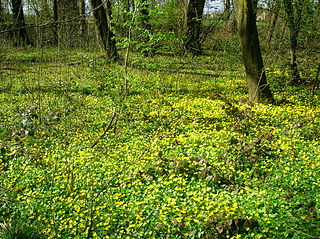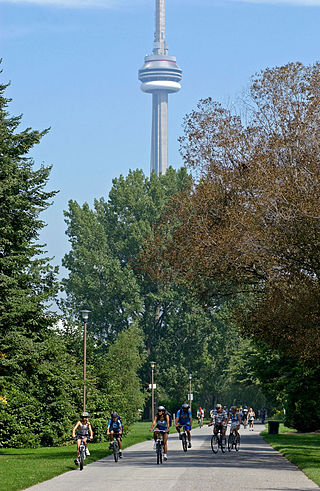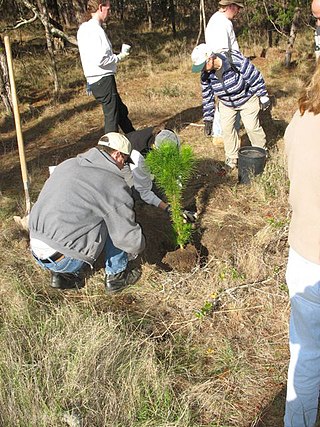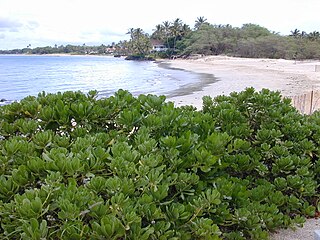
The city of Atlanta, Georgia has a reputation as the "city in a forest" due to its abundance of trees, uncommon among major cities. Tree coverage was estimated at 47.9% for 2008, in a 2014 study. [1]

The city of Atlanta, Georgia has a reputation as the "city in a forest" due to its abundance of trees, uncommon among major cities. Tree coverage was estimated at 47.9% for 2008, in a 2014 study. [1]
Atlanta, often called a "city in a forest" and a "tree haven", has a large tree canopy covering much of its area. [2] [3] [4] [5] [6] The city's main street is named after a tree, and beyond the Downtown, Midtown, and Buckhead business districts, the skyline gives way to a dense canopy of woods that spreads into the suburbs. The city's tree coverage percentage was estimated at 36% in a 2004 model. [7] A 2010 study estimated its tree coverage at 50-53%. [8]
Atlanta's tree coverage does not go unnoticed—it was the main reason cited by National Geographic in naming Atlanta a "Place of a Lifetime": [9]
For a sprawling city with the nation’s ninth-largest metro area, Atlanta is surprisingly lush with trees—magnolias, dogwoods, Southern pines, and magnificent oaks. [10]
The city's lush tree canopy, which filters out pollutants and cools sidewalks and buildings, has increasingly been under assault from man and nature due to heavy rains, drought, aged forests, new pests, and urban construction. A 2001 study found that Atlanta's heavy tree cover declined from 48% in 1974 to 38% in 1996. This loss of tree canopy resulted in a 33% increase in stormwater runoff, and a loss of 11 million pounds of pollutants removed annually, a value of approximately $28 million per year. [11] Due to a historic drought in the late 2000s, Atlanta lost trees at an unprecedented rate. For example, Piedmont Park lost about a dozen large, historic trees in 2009, compared to two or three during normal years. Although many of Atlanta's trees are between 80 and 100 years old and thus reaching the end of their normal lifespan, the drought accelerated their demise by shrinking the trees' roots. However, the problem is being addressed by community organizations and city government. [3] Trees Atlanta, a non-profit organization founded in 1985, has planted and distributed over 126,000 shade trees. [12] Atlanta's city government awarded $130,000 in grants to neighborhood groups to plant trees. [3]
The city is home to the Atlanta Dogwood Festival, an annual arts and crafts festival held one weekend during early April, when the native dogwoods are in bloom.
Proposed construction of a police training facility in the South River Forest—a 80-acre greenspace (32 ha) in southeast Atlanta and Dekalb county—has led to ongoing protests. Conservationists and activists oppose the project and built encampments in and around the old Atlanta prison farm during 2021 and 2022. This has led to multiple confrontations with police. [13] [14] [15]
The low-density residential subdivision development that dominates the Atlanta area has historically not been required to replace lost tree inventory.[ citation needed ] Because of larger lot sizes and natural-looking architecture, such as California contemporary, older neighborhoods typically have many mature forest trees, except in cases where they have been destroyed by homeowners.[ citation needed ] Increasing density allowed by zoning since the 1980s has meant fewer and fewer trees left, and by the 2000s it became common for developers to completely clearcut dozens of acres of forest and bulldoze all hills flat to build generic tract housing, often with tightly packed homes nearly touching each other and up against the street.[ citation needed ] However, over the past decade some area cities and counties have revised their tree ordinances to require tree recompense to be equal to or greater than the pre-development tree density, trying to ensure a future tree canopy. Rather than leaving trees on each home lot as before, this typically involves a set-aside of green space in each development, with most other areas still clear-cut. Even when some trees are replaced, it is with a single type of trees planted the same distance from each other, rather than different trees at random placement and age as in the native forest. At a rate of 50 acres (20 hectares) per day,[ citation needed ] the deforestation brought by land development has had a significant impact on area watersheds, as they now flood far more rapidly and to a much greater extent than prior to development.[ citation needed ]
The American Institute of Architecture's 1993 Guide to the Architecture of Atlanta wrote:
[T]he city's greatest natural asset, its lush vegetation and gently rolling topography, which eighty years ago enabled Druid Hills to become one of the most beautiful Olmstedian garden suburbs in North America, distinguishes Atlanta's highway architecture from suburban office complexes in other boom towns like Houston and Tampa. [16]
Author Tom Wolfe wrote in A Man in Full :
He looked away from the buildings and out over the ocean of trees. Since Atlanta was not a port city and was, in fact, far inland, the trees stretched on in every direction. They were Atlanta's greatest natural resource, those trees were. People loved to live beneath them. [17]

Atlanta is the capital and most populous city in the U.S. state of Georgia. It is the seat of Fulton County, and a portion of the city extends into neighboring DeKalb County. With a population of 498,715 living within the city limits, Atlanta is the eighth most populous city in the Southeast and 38th most populous city in the United States according to the 2020 U.S. census. It is the core of the much larger Atlanta metropolitan area, which is home to more than 6.3 million people, making it the sixth-largest U.S. metropolitan area. Situated among the foothills of the Appalachian Mountains at an elevation of just over 1,000 feet (300 m) above sea level, Atlanta features unique topography that includes rolling hills, lush greenery, and the densest urban tree coverage of any major city in the United States.

A forest is an ecosystem characterized by a dense community of trees. Hundreds of definitions of forest are used throughout the world, incorporating factors such as tree density, tree height, land use, legal standing, and ecological function. The United Nations' Food and Agriculture Organization (FAO) defines a forest as, "Land spanning more than 0.5 hectares with trees higher than 5 meters and a canopy cover of more than 10 percent, or trees able to reach these thresholds in situ. It does not include land that is predominantly under agricultural or urban use." Using this definition, Global Forest Resources Assessment 2020 found that forests covered 4.06 billion hectares, or approximately 31 percent of the world's land area in 2020.

In forestry and ecology, understory, or understorey, also known as underbrush or undergrowth, includes plant life growing beneath the forest canopy without penetrating it to any great extent, but above the forest floor. Only a small percentage of light penetrates the canopy so understory vegetation is generally shade-tolerant. The understory typically consists of trees stunted through lack of light, other small trees with low light requirements, saplings, shrubs, vines and undergrowth. Small trees such as holly and dogwood are understory specialists.

Cornus florida, the flowering dogwood, is a species of flowering tree in the family Cornaceae native to eastern North America and northern Mexico. An endemic population once spanned from southernmost coastal Maine south to northern Florida and west to the Mississippi River. The tree is commonly planted as an ornamental in residential and public areas because of its showy bracts and interesting bark structure.

Urban forestry is the care and management of single trees and tree populations in urban settings for the purpose of improving the urban environment. Urban forestry involves both planning and management, including the programming of care and maintenance operations of the urban forest. Urban forestry advocates the role of trees as a critical part of the urban infrastructure. Urban foresters plant and maintain trees, support appropriate tree and forest preservation, conduct research and promote the many benefits trees provide. Urban forestry is practiced by municipal and commercial arborists, municipal and utility foresters, environmental policymakers, city planners, consultants, educators, researchers and community activists.

The Atlanta Botanical Garden is a 30 acres (12 ha) botanical garden located adjacent to Piedmont Park in Midtown Atlanta, Georgia, United States. Incorporated in 1976, the garden's mission is to "develop and maintain plant collections for the purposes of display, education, conservation, research and enjoyment."

An old-growth forest is a forest that has developed over a long period of time without disturbance. Due to this, old-growth forests exhibit unique ecological features. The Food and Agriculture Organization of the United Nations defines primary forests as naturally regenerated forests of native tree species where there are no clearly visible indications of human activity and the ecological processes are not significantly disturbed. One-third of the world's forests are primary forests. Old-growth features include diverse tree-related structures that provide diverse wildlife habitats that increases the biodiversity of the forested ecosystem. Virgin or first-growth forests are old-growth forests that have never been logged. The concept of diverse tree structure includes multi-layered canopies and canopy gaps, greatly varying tree heights and diameters, and diverse tree species and classes and sizes of woody debris.
The Carolinian forest refers to a life zone in eastern North America characterized primarily by the predominance of deciduous (broad-leaf) forest. The term "Carolinian", which is most commonly used in Canada, refers to the deciduous forests which span across much of the eastern United States from the North Carolina northward into southern Ontario, Canada. These deciduous forests in the United States and southern Ontario share many similar characteristics and species hence their association. Today the term is often used to refer to the Canadian portion of the deciduous forest region while the portion in the United States is often referred to as the "Eastern deciduous forest".

An urban forest is a forest, or a collection of trees, that grow within a city, town or a suburb. In a wider sense, it may include any kind of woody plant vegetation growing in and around human settlements. As opposed to a forest park, whose ecosystems are also inherited from wilderness leftovers, urban forests often lack amenities like public bathrooms, paved paths, or sometimes clear borders which are distinct features of parks. Care and management of urban forests is called urban forestry. Urban forests can be privately and publicly owned. Some municipal forests may be located outside of the town or city to which they belong.

Fernbank Forest is a 65-acre mature mixed forest that is part of Fernbank Museum of Natural History in Atlanta, Georgia. It has some relatively old trees compared to much of the forests in the Piedmont; as such, it has been extensively studied by scientists. Large specimens of white oak and tulip poplar, which grow up to 156 feet tall, can be found along one slope within the forest. There also are a few equally tall loblolly pine. Other canopy species include American beech, black oak, northern red oak, southern red oak, pignut hickory, bitternut hickory, mockernut hickory, winged elm and red maple. Eastern flowering dogwood, sourwood, umbrella magnolia and eastern redbud are prominent among the smaller trees. The forest floor is covered by many shrub, wildflower, and fern species.

Frangula alnus, commonly known as alder buckthorn, glossy buckthorn, or breaking buckthorn, is a tall deciduous shrub in the family Rhamnaceae. Unlike other "buckthorns", alder buckthorn does not have thorns. It is native to Europe, northernmost Africa, and western Asia, from Ireland and Great Britain north to the 68th parallel in Scandinavia, east to central Siberia and Xinjiang in western China, and south to northern Morocco, Turkey, and the Alborz in Iran and the Caucasus Mountains; in the northwest of its range, it is rare and scattered. It is also introduced and naturalised in eastern North America.

Forestry in India is a significant rural industry and a major environmental resource. India is one of the ten most forest-rich countries of the world. Together, India and 9 other countries account for 67 percent of the total forest area of the world. India's forest cover grew at 0.20% annually over 1990–2000, and has grown at the rate of 0.7% per year over 2000–2010, after decades where forest degradation was a matter of serious concern.

In the central and southern Appalachian Mountains of Eastern North America, a cove is a small valley between two ridge lines that is closed at one or both ends.

Forest dieback is a condition in trees or woody plants in which peripheral parts are killed, either by pathogens, parasites or conditions like acid rain, drought, and more. These episodes can have disastrous consequences such as reduced resiliency of the ecosystem, disappearing important symbiotic relationships and thresholds. Some tipping points for major climate change forecast in the next century are directly related to forest diebacks.

Native trees in Toronto are trees that are naturally growing in Toronto and were not later introduced by humans. The area that presently comprise Toronto is a part of the Carolinian forest, although agricultural and urban developments destroyed significant portions of that life zone. In addition, many of Toronto's native trees have been displaced by non-native plants and trees introduced by settlers from Europe and Asia from the 18th century to the present. Most of the native trees are found in the Toronto ravine system, parks, and along the Toronto waterway system.

Xeriscaping is the process of landscaping, or gardening, that reduces or eliminates the need for irrigation. It is promoted in regions that do not have accessible, plentiful, or reliable supplies of fresh water and has gained acceptance in other regions as access to irrigation water has become limited, though it is not limited to such climates. Xeriscaping may be an alternative to various types of traditional gardening.

Piscidia piscipula, commonly named Florida fishpoison tree, Jamaican dogwood, or fishfuddle, is a medium-sized, deciduous, tropical tree in the Fabaceae family. It is native to the Greater Antilles, extreme southern Florida and the Bahamas, and the coastal region from Panama northward to the vicinity of Ocampo, Tamaulipas, Mexico. The native Taino of the West Indies discovered that extracts from the tree could sedate fish, allowing them to be caught by hand. This practice led to the tree's common names—fishpoison and fishfuddle. The tree has medicinal value as an analgesic and sedative.

Conservation in India can be traced to the time of Ashoka, tracing to the Ashoka Pillar Edicts as one of the earliest conservation efforts in the world. Conservation generally refers to the act of carefully and efficiently using natural resources. Conservation efforts begun in India before 5 AD, as efforts are made to have a forest administration. The Ministry of Environment, Forest and Climate Change is the ministry responsible for implementation of environmental and forestry program in India, which include the management of national parks, conservation of flora and fauna of India, and pollution controls.

Urban reforestation is the practice of planting trees, typically on a large scale, in urban environments. It may also include urban horticulture and urban farming.

Tropical vegetation is any vegetation in tropical latitudes. Plant life that occurs in climates that are warm year-round is in general more biologically diverse that in other latitudes. Some tropical areas may receive abundant rain the whole year round, but others have long dry seasons which last several months and may vary in length and intensity with geographic location. These seasonal droughts have great impact on the vegetation, such as in the Madagascar spiny forests.